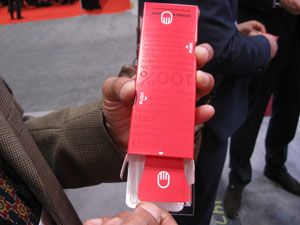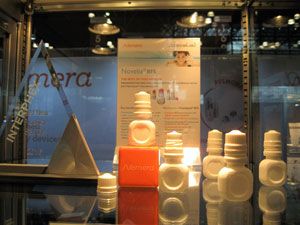First-time Packaging Exhibitors Bring Innovations to INTERPHEX
Equipment and Processing Report
Packaging technologies for serialization, parenteral products, and solid-dosage forms were displayed at INTERPHEX 2016.
INTERPHEX 2016 (April 26–29, New York, NY) featured more than 100 first-time exhibitors. Many of the newcomers displayed packaging innovations for serialization, solid-dosage forms, and parenteral products.
Serialization and secure packaging
Laetus, a familiar name in machine vision, simplifies the transition to serialization, shortens integration time, and reduces the capital investment with its MV-50to go standardized serialization solution. Requiring only 18 inches of line space, the system fits on most packaging lines. The system transports cartons for printing by a continuous inkjet printer. The software accepts serialized data from an upper level system or memory stick and transmits the codes to the printer and camera so the camera can confirm code correctness and print quality. A fail-safe rejection system prevents cartons with incorrect or poorly printed codes from proceeding down the line.
The MV-50to go standardized serialization system handles cartons. Laetus also supplies serialization systems for bundling, case packing, and aggregation. All images are courtesy of the author.

Another first-time exhibitor that supports serialization, Nutec Systems, demonstrated a single BlackBox controller capable of managing multiple print technologies for serializing at the unit dose, label, carton, and case level. The same BlackBox system can also control multiple vision-inspection systems including smart sensors to detect print presence or perform pattern matching or a smart camera for print character and code verification. Customized systems can be supplied with Nutec’s Track & Trace software and cheQAssure Quality Assurance Software Suite for use with GS1 codes.
Ellis Paper Box produces metallized, folding cartons with mirror-like, Fresnel lens patterns. The company also produces conventional cartons with anticounterfeiting features such as cold foil, a coin-reactive strip for authentication, two-dimensional DataMatrix code, serialization, micro type, pattern coating, and radio frequency identification (RFID) tags. RFID tags interact with a Smartphone to display information such as a patient insert in a specified language or enable the consumer to contact the brand owner directly. “A QR code can’t be changed, but an RFID message can be,” Steve Kerr, senior account manager, Ellis Paper Box, explained in an interview on the show floor. The company also can tip (attach) inserts to the interior of the carton, emboss Braille messages, add tamper-evident devices, and apply electronic article surveillance tags.
Holo-Technologies offers three layers of security: one for end users; one for distributors, which is authenticated with ultraviolet light; and one for the brand owner, which is verified with a microscope. Its substrate, metallized polyethylene terephthalate film in gauges from 25–250 mils, can be laminated to paper or paperboard, and features difficult-to-duplicate technologies such as bas-relief, microtext, nanotext, 3D animated image, laser-etched barcoding, embossed light diffraction patterns, and microswitch effects, where the message changes as the viewing angle shifts. A tamper-evident security seal also is available.
Sanjeet Saxena, director Business Development at Locked4Kids, demonstrates how pushing offset tabs on a CR/SF carton provides access to blister cards.

Offset push tabs unlock access to blister packs in a child-resistant/senior-friendly carton from Locked4Kids. The design, which is available for licensing, can be produced by any carton manufacturer and loaded on standard cartoning machines. As a result, “No new machines are needed, and a brand owner can use its own [carton] supply chain,” Sanjeet Saxena, director Business Development at Locked4Kids told Pharmaceutical Technology.
Liquid filling and packaging
In the parenteral space, Colanar displayed a servo-driven, tabletop filling line available in three options: laminar flow workbench, restricted access barrier system, or isolator. Nests of vials, syringes, or cartridges ride on a platform that indexes forward for filling, and a pick-and-place arm applies stoppers. Syringe plungers are placed using vacuum. Vials can be handled at 30 per minute in a single station machine or 60 per minute in the duplex model. Syringes are filled slower, at 15 per minute. Applications include research and development, biotech, contract packagers, and compounding pharmacies.
A first-time exhibitor from France, Nemera, offers multi-dose dispensers for preservative-free products such as eye drops. Preservative-free technology is well established in Europe and also was featured by Ursatec Verpackung (a first-time INTERPHEX exhibitor in 2015), and Aptar Pharma.
Prestige Brands has adopted Aptar Pharma’s Ophthalmic Squeeze Dispenser for multi-dose formulas of Clear Eyes Pure Relief eye drops. It’s reportedly the first over-the-counter, preservative-free, multi-dose eye drop available in the United States (1). A valve in the dispenser opens to release a drop and recloses to seal contents from the outside environment. An integral filter cleans the air that enters the bottle to replace the fluid.
The Novelia BFS system from Nemera for multi-dose, preservative-free ophthalmic liquids won the Best New Product/Service Award in the 2016 Interphex Exhibitor Awards competition.

Nemera’s latest design for multi-dose, preservative-free products is the Novelia BFS system. Utilizing bottelpack blow-fill-seal (BFS) machines from Rommelag, containers can be produced in many sizes and shapes. A one-way valve associated with a permeable Pureflow silicone membrane prevents ingress of contaminants. A blue tip aids aiming for accurate drop dispensing, and calibrated drops ensure a precise dose. Three variations handle viscosities up to 1500 cP.
A square-bottom, metallized polyester, standup pouch prototype from Bernhardt can be sized to hold between 1–5 L of liquid and is easy to fill and pour through a standard fitment. The sturdy pouch structure survives 80-cm drop tests and eliminates the need for a secondary box. A cube-efficient shape permits top-to-bottom or side-to-side stacking to fit up to 30% more product per pallet. A handle or hanging holes can be diecut top and/or bottom.
Reference
- Prestige Brands, Clear Eyes Pure Relief, www.cleareyes.com/purerelief, accessed May 6, 2016.
Drug Solutions Podcast: A Closer Look at mRNA in Oncology and Vaccines
April 30th 2024In this episode fo the Drug Solutions Podcast, etherna’s vice-president of Technology and Innovation, Stefaan De Koker, discusses the merits and challenges of using mRNA as the foundation for therapeutics in oncology as well as for vaccines.
